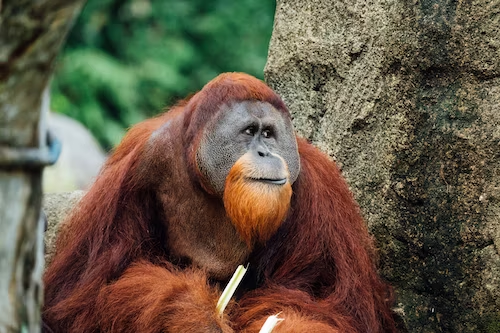
In the heart of Borneo and Sumatra, three distinct orangutan subspecies – the Bornean, Sumatran, and Tapanuli Orangutans – teeter on the brink of extinction. These remarkable great apes, characterised by their striking reddish-brown hair, have a significant impact on their forest ecosystems. This blog will examine the challenges facing these orangutans, their diminishing populations, and the imperative of conservation efforts.
Orangutans: Bornean, Sumatran, and Tapanuli
As Asia’s only great apes, orangutans are a unique treasure of Indonesia. The Bornean orangutan (Pongo pygmaeus), Sumatran orangutan (Pongo abelii), and the recently discovered Tapanuli orangutan (Pongo tapanuliensis) make up the three subspecies. Each of these orangutan subspecies has distinctive physical characteristics and enriches their habitats in their unique ways.
The Bornean orangutans are the most robust and have the darkest hair. Sumatran orangutans are lighter and longer haired, and males have a broader face. The Tapanuli orangutan has frizzier hair and a smaller head but is similar in size to its Bornean and Sumatran cousins.
Sadly, all three subspecies are listed by the International Union for Conservation of Nature (IUCN) as Critically Endangered, emphasising the urgent need for robust conservation measures to secure their survival.
Beyond their physical distinctions, orangutans play a crucial ecological role as the forest’s unseen gardeners. These tree-dwelling fruit eaters consume a wide variety of fruits, with seeds from the fruits travelling through their digestive system before being deposited in new locations – this takes about 76 hours.
Females, sticking closer to their home ranges, disperse seeds around their feeding grounds. In contrast, males, who travel further, carry seeds to new, more distant areas. This crucial seed dispersal by orangutans contributes significantly to the biodiversity of the forest ecosystem, promoting the health and growth of their habitats.
The Threat Caused by Human Activities
Forests, the homes of orangutans, are not just collections of trees — they are complex ecosystems that play an indispensable role in maintaining our planet’s health. They serve as a massive carbon sink, help regulate water cycles, maintain soil health, and support an astonishing variety of life forms.
However, the increasing influence of human activity has affected some parts of the orangutans’ home, presenting challenges to these ecosystems and their inhabitants. Orangutans, the largest arboreal mammals, are critically affected by this trend. The loss and fragmentation of their habitats reduce these creatures’ living spaces and confine them to isolated pockets of forest. This isolation not only leads to a decrease in genetic diversity and weakens their resilience to diseases and environmental changes, it also hinders their crucial role in seed dispersal — an essential process for the growth and diversification of the forest as mentioned above.
In addition, the overlap of human activities with orangutan habitats can sometimes lead to unfortunate interactions between humans and orangutans, resulting in these apes being relocated from their habitats or harmed. Simultaneously, the illegal pet trade, with a particular focus on the capture of infant orangutans, further contributes to their population decline.
The impacts of habitat loss reach far beyond orangutans. This triggers a cascade of effects that endanger the entire biodiversity of the region. It exacerbates climate change, disrupts water cycles, and puts countless other species who call these forests home at risk.
To counter this daunting scenario, conservation efforts like those undertaken by Asia Pulp & Paper (APP) Sinar Mas, a prominent pulp and paper company, are indispensable. These initiatives underscore the need to safeguard not only the orangutans but also the invaluable forests they help maintain, highlighting the deep interconnectedness of all life forms on our planet.
A Beacon of Hope: Conservation Efforts
Conservation efforts from various stakeholders, including governments, non-governmental organisations, and corporations, offer a beacon of hope for orangutans and their habitats. Various measures, such as legal protection for orangutans and their habitats, rehabilitation, reintroduction programmes, as well as educational initiatives to raise awareness about these beautiful creatures, are being undertaken. An essential part of these efforts is also to create and maintain sustainable agricultural practices that minimise forest destruction.
APP’s Commitment to Biodiversity Conservation
APP, a significant player in the pulp and paper industry, is a staunch advocate of biodiversity conservation. The company recognises the vital role forests play in sustaining the planet’s health and the crucial place of orangutans within these ecosystems. APP is committed to responsible production practices that balance economic growth with environmental sustainability.
APP has taken decisive steps towards safeguarding and enhancing orangutan habitats. These include setting aside substantial areas of its concessions for conservation, working with communities to prevent human-orangutan conflict, and collaborating with conservation organisations on research and protection efforts. This way, APP contributes to the long-term survival of orangutans and the biodiversity of their habitats.
An Urgent Plea for Action
Despite these encouraging initiatives, the situation facing orangutans remains critical. The rapid changes in their environment and the many threats orangutans face call for more urgent and extensive action. More than ever, there is a need for a collective effort from all sectors of society, from governments and corporations to communities and individuals.
In our hands, we hold the power to determine the fate of these unique forest gardeners and the rich, diverse ecosystems they support. Let’s act today to ensure that the orangutans, these incredible symbols of the wild, continue to thrive in the heart of Borneo and Sumatra for generations to come.
